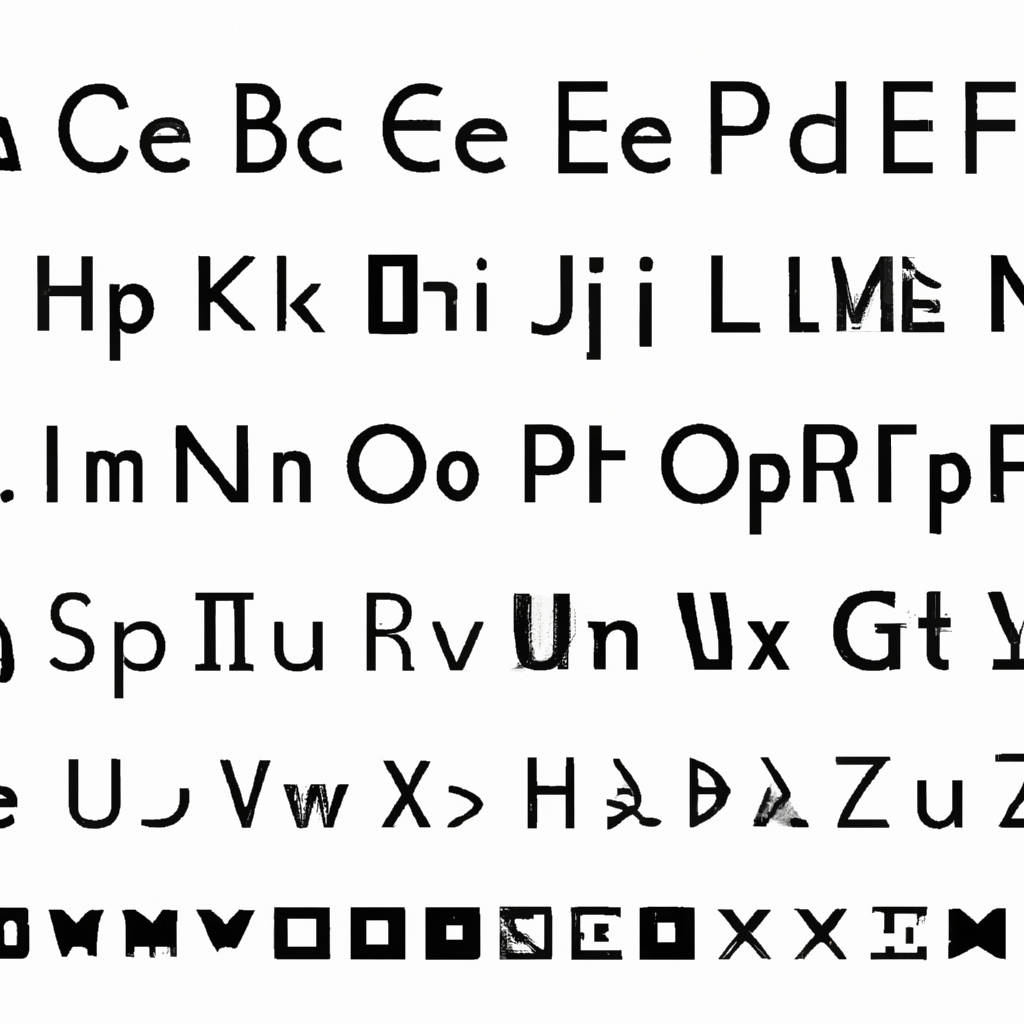When it comes to crafting the perfect resume, choosing the right fonts can make a significant difference in how your document is perceived by potential employers. Your choice of fonts can convey a sense of professionalism, creativity, or attention to detail. It’s important to select fonts that are easy to read and visually appealing, as this will help your resume stand out from the competition.
Some popular font choices for resumes include Arial, Calibri, and Times New Roman. These fonts are clean, simple, and easy to read on both printed and digital versions of your resume. It’s also important to consider the size and spacing of your fonts, as this can impact the overall readability of your resume. Aim for a font size of 10-12 points and use appropriate spacing between lines and sections to ensure that your resume is easy to scan and digest.
Ultimately, the fonts you choose for your resume should reflect your personal style and the image you want to project to potential employers. So take some time to experiment with different fonts and find the perfect combination that will make your resume stand out in a sea of applicants.
Optimal Readability: Ensuring Clarity and Ease of Reading
Optimal readability is essential for effectively communicating information to a wide audience. When text is clear and easy to read, readers are more likely to understand and retain the information being presented. There are several key factors that contribute to optimal readability, including font size, typeface, spacing, and organization. Choosing a font size that is neither too small nor too large, selecting a clean and simple typeface, and using appropriate spacing between lines and paragraphs all play a crucial role in enhancing readability. Additionally, organizing the content in a logical and coherent manner can help readers follow the flow of information more easily.
Another important aspect of optimal readability is the use of headings, subheadings, and bullet points to break up large blocks of text and highlight key points. This not only makes the text more visually appealing but also helps to guide the reader through the content in a structured way. In addition, using clear and concise language, avoiding jargon and technical terms whenever possible, can further enhance readability by making the text more accessible to a wider audience.
It is also important to consider the needs of different readers, including those with visual impairments or learning disabilities. Providing alternative formats such as audio versions or accessible documents can help ensure that all readers are able to access and understand the information being presented. Finally, seeking feedback from readers and making revisions based on their input can help to improve the overall readability of a text. By taking these factors into account and making conscious efforts to enhance readability, writers can ensure that their content is clear, engaging, and easily understood by a diverse audience.

Professional Appeal: Selecting Fonts That Convey a Polished Image
Choosing the right font is crucial when trying to convey a professional image. Fonts play a significant role in how a document or presentation is perceived by others. When selecting fonts for professional use, it is important to choose ones that are clean, easy to read, and convey a sense of sophistication. Fonts such as Arial, Times New Roman, and Calibri are popular choices for professional documents as they are versatile and legible.
These fonts are often used in business correspondence, reports, and presentations to convey a polished and professional image. In contrast, using overly decorative or unusual fonts can detract from the professionalism of a document and may be perceived as unprofessional or lacking in credibility. Additionally, it is important to consider the size and spacing of the font to ensure that the text is easy to read and visually appealing.
Overall, selecting the right font is an important aspect of creating a professional image and should be given careful consideration to ensure that the message is conveyed effectively and professionally. By choosing fonts that are clean, easy to read, and sophisticated, individuals can create a polished image that will leave a lasting impression on others.
Compatibility and Accessibility: Ensuring Readability Across Platforms
In today’s digital age, ensuring compatibility and accessibility across platforms is crucial for reaching a wider audience and ensuring readability of content. With the proliferation of devices and operating systems, it is important for content creators to consider how their content will be displayed and accessed by users on different platforms. This includes making sure that websites are mobile-responsive, emails are easily readable on different email clients, and documents are accessible to those using assistive technologies.
By making content compatible and accessible across platforms, organizations can increase their reach and engagement with users, as well as improve the overall user experience. Additionally, ensuring readability across platforms can help to enhance the brand’s reputation and credibility, as users are more likely to trust and engage with content that is easily accessible and user-friendly.
In order to achieve compatibility and accessibility, content creators should prioritize using responsive design principles, testing content on different devices and browsers, and adhering to web accessibility standards such as WCAG. By taking these steps, content creators can ensure that their content is readable and engaging for all users, regardless of the platform they are using. Ultimately, prioritizing compatibility and accessibility across platforms is not only beneficial for the organization, but also for the users who rely on accessible and user-friendly content to engage with the digital world.
Consistency in Style: Matching Fonts to Your Industry and Role
Consistency in style is crucial when it comes to choosing fonts for your industry and role. Different fonts convey different messages, and it is important to match the fonts you use to the image you want to portray. For example, if you work in a creative industry such as graphic design or advertising, you may want to choose fonts that are more modern and edgy to reflect your innovative and artistic nature. On the other hand, if you work in a more traditional industry such as finance or law, you may want to choose more classic and professional fonts to convey a sense of trust and reliability.
Additionally, it is important to consider your specific role within your industry when choosing fonts. For example, if you are in a leadership position, you may want to choose fonts that are bold and commanding to reflect your authority. On the other hand, if you are in a more supportive role, you may want to choose fonts that are more subtle and understated to convey a sense of approachability and helpfulness.
In addition to matching fonts to your industry and role, it is also important to maintain consistency in style across all of your marketing materials and communications. This helps to establish a strong and cohesive brand identity that will be easily recognizable to your audience. Consistency in style also helps to build trust with your customers and clients, as it shows that you are professional and organized in your approach.
Overall, choosing the right fonts for your industry and role, and maintaining consistency in style across all of your materials, is essential for creating a strong and effective brand image. By paying attention to these details, you can ensure that your fonts are working for you and helping to convey the right message to your audience.

Avoiding Overly Decorative Fonts: Opting for Simplicity and Legibility
When it comes to selecting fonts for design projects, it is essential to keep in mind the importance of simplicity and legibility. While overly decorative fonts may seem appealing at first glance, they can often be difficult to read and may detract from the overall message of the design.
Opting for simpler, more straightforward fonts can help ensure that the text is easily readable and that the intended message is conveyed clearly to the audience. Additionally, using legible fonts can also help improve the overall aesthetic of the design, as they tend to be more visually appealing and can create a more cohesive look.
By prioritizing simplicity and legibility when choosing fonts, designers can create more effective and visually appealing designs that effectively communicate their message to the audience. Ultimately, the goal of any design project should be to effectively convey the intended message to the audience, and selecting fonts that are simple and legible can help achieve this goal.
Font Pairing: Creating Harmony Between Headings and Body Text
Font pairing is an essential aspect of design that can greatly impact the overall aesthetic and readability of a piece of text. When choosing fonts for headings and body text, it is important to create harmony between the two to ensure a cohesive and visually appealing design. By selecting fonts that complement each other in style, size, and weight, designers can create a sense of unity and balance between the different elements of a layout.
For example, pairing a bold and attention-grabbing font for headings with a more subtle and easy-to-read font for body text can help guide the reader’s eye and enhance the overall readability of the content. Additionally, using fonts that have similar characteristics, such as similar x-heights or letterforms, can help create a sense of consistency and coherence throughout a design.
Overall, font pairing is a powerful tool that can be used to enhance the visual impact and effectiveness of typography in design projects. By carefully selecting and pairing fonts for headings and body text, designers can create a harmonious and visually pleasing layout that effectively conveys the intended message to the audience.

Conclusion
In conclusion, it is evident that there are various factors to consider when making decisions. It is important to weigh the potential consequences and impacts of our actions on ourselves and others. It is crucial to reflect on our values and beliefs in order to make choices that align with our personal principles. Additionally, seeking feedback and advice from trusted individuals can provide valuable insights and perspectives that we may not have considered on our own.
Ultimately, the choices we make can shape our future and influence the world around us. By being mindful and intentional in our decision-making process, we can strive to make choices that are in line with our values and contribute to our overall well-being. It is through this thoughtful approach that we can navigate the complexities of life and make informed decisions that will lead to positive outcomes.
As we continue to evolve and grow, it is important to remember that our choices have the power to impact not only ourselves but also those around us. Therefore, it is essential to consider the broader implications of our actions and strive to make decisions that reflect our values and beliefs. In conclusion, by being mindful and intentional in our decision-making process, we can work towards creating a more harmonious and fulfilling life for ourselves and those around us.
